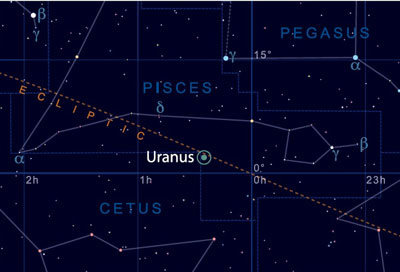
Find Uranus at its best
BY MARK ARMSTRONG
ASTRONOMY NOW
Posted: 27 September 2012


 Find Uranus on the border of Pisces and Cetus. AN Graphic: Greg Smye-Rumsby.
Find Uranus on the border of Pisces and Cetus. AN Graphic: Greg Smye-Rumsby.
The seventh planet, mysterious and remote Uranus comes to opposition on 29 September. The ice giant is technically a naked-eye object glowing at magnitude +5.7, but in practice you will want some optical help in the form of binoculars or a small telescope to track it down. This is definitely the case near opposition this year as a near-full Moon is within five degrees on opposition night. Any telescope operating at powers at or above x30 will show a greenish disc 3.7 arcseconds in diameter; this year Uranus is as close as 13 arcminutes to the star 44 Piscium which just happens to have an almost identical magnitude as Uranus, making for an interesting comparison; can you tell them apart?
Uranus was discovered in 1781 and lies 2,900 million kilometres from Earth (average distance from Earth at opposition 18.19 Astronomical Units AU). Uranus takes 84 years to complete one orbit around the Sun (average distance 19.19 AU), has an unusual axial tilt of 98 degrees, essentially rotating on its side in 17.24 hours.
After what seems like an eternity for observers in the Northern Hemisphere, Uranus has now moved just north of the celestial equator with a declination close to +2 degrees. This gives it a reasonable altitude of 40 degrees above the southern horizon when transiting the meridian just before 1am BST. The planet will be above 20 degrees altitude from 9pm to 4.30am, so there's a good chance to observe it at some stage. It's precise position on opposition night is R.A. 00h 25m 16s, Decl. +01° 54' 49". Even in good seeing conditions Uranus' disc gives up little if any surface detail but modern imaging techniques can produce stunning images and it's just thrilling to see and record the planet's disc anyway!
Uranus has a retinue of 27 moons but only five are within range of amateur instruments. In order outwards from the planet they are Miranda, Ariel, Umbriel, Titania amd Oberon. Imagers can record these moons with CCD's or DSLR's when they are at a decent elongation from Uranus and 13th magnitude Titania and Oberon can be detected visually if you have a 300-mm aperture 'scope. All you will see or image or mere points of light as they are too small and remote to record discs, but once again, it's a thrill to bag them.
|



